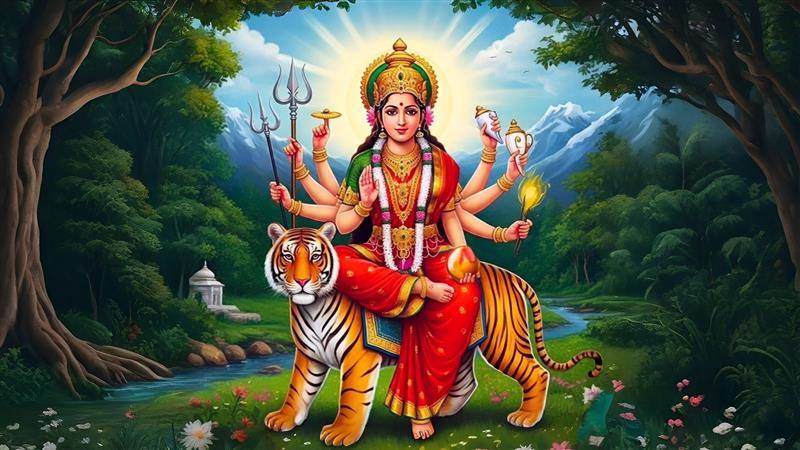
Shakti Peethas are the powerful places of worship dedicated to Goddess Shakti, the most important feminine divine energy in Hinduism. It is the significant pilgrimage center for the devotees and dedicated to various forms of the goddess Shakti.
According to the Sri Devi Bhagavat Purana, there are 108 Shakti Peethas. Shiva Charitra mentions 51 Shakti Peethas. Out of which, 18 Shakti Peethas are very auspicious and are called Ashta Dasha Shakti Peethas. The 18 Shakti Peethas are the powerful abodes of Shakti and they have been revered by Adi Guru Shankaracharya in his Ashta Dasha Shakti Peetha Stotra.
The Shakti Peethas are sacred sites spread across India and neighboring countries like Sri Lanka, Nepal, Tibet, Pakistan, and Bangladesh. Behind every Shakti Peetha is an association with a different body part or ornament of Sati Devi.
Vedic History of Shakti Peetha
Sati Devi, or Dakshayani, is the youngest and most beloved daughter of King Daksha and Prasuti. King Daksha prayed to Adi Para Shakti and asked her to be born as his daughter. Adi Para Shakti agreed but set a condition: she would leave her body if he ever disrespected her.
From childhood, Sati Devi became devoted to Lord Shiva by hearing lilas about him. As she grew, her devotion turned into love. However, Daksha had a huge hatred for Lord Shiva. When Sati Devi reached marriageable age, Daksha conducted Swayamvara for Sati Devi. He invited all prominent personalities in the universe but did not invite Lord Shiva.
But Sati Devi chose Shiva, considering him as her husband. Lord Shiva accepted her and took her to his abode, Kailash. This incident angered King Daksha.
On another such incident, once King was invited for a yagna in which Lord Shiva was also present. As Daksha entered into the yagna hall, everybody stood to honor Daksha except Lord Shiva. Daksha considered this to be a great insult towards him, making him hate Lord Shiva further.
Once King Daksha conducted a yagna and invited all prominent personalities of the universe except Lord Shiva and Sati Devi.
As everyone was flying in the sky to attend the Daksha yagna. Sati Devi noticed the crowd moving in one direction. Out of curiosity, she asked them where they were headed. They all responded that they were going to attend the yagna conducted by her father.
Sati felt deep sorrow inside her heart that her father didn’t invite them. She felt a desire to attend the yagna conducted by her father and persistently asked her husband, Lord Shiva, to give permission to attend. Though Lord Shiva denied many times, she was very adamant.
Lord Shiva said, since we are not invited, it is not good to attend the yagna. Sati Devi disregarded the words of Lord Shiva; she went to attend the yagna along with Nandi, the vehicle of Lord Shiva.
When she enters the Yagna place, she finds that there is no single seat reserved for Lord Shiva. Every yagna has an Aahuti to Lord Shiva. However, in this yagna, there was not even a single seat reserved for Lord Shiva.
Sati Devi felt very bad for insulting her husband to this level. When asked about it, Daksha started insulting Lord Shiva in front of everyone.
Unable to tolerate the insult made by King Daksha to Lord Shiva, she decided to give away her body given by Daksha. Before giving away her body, Sati Devi created a fire in which she self-immolated herself.
This news immediately reached the ears of Lord Shiva. Unable to tolerate the separation from his wife, being filled with rage, he created Veerabhadra and sent him to destroy the yagna and kill Daksha.
There was a huge battle with Daksha sided by devatas and Lord Shiva, along with the bhuta ganas and rudra ganas. Everybody who participated was killed; all the sages left that place, and finally the head of Daksha was severed by Veerabhadra.
Unable to bear the separation from his dear wife, Lord Shiva took the corpse of Sati Devi on his shoulder and started roaming from forest to forest, from forest to mountains, and all other places like a madman who had no purpose in his life. Lord Shiva started performing Rudra Tandava, and the whole world got panicked, and none could pacify Lord Shiva.
To restore the peace to the world, Lord Brahma and other devatas prayed to Lord Vishnu for a solution.
Lord Vishnu, using his Sudarshana, severed the body of Sati Devi, and it fell into different parts of the world. The place where it fell is called Shakti Peetha and is worshiped as Shakti in different forms and names.
Ashta Dasha Shakti Peethas Stotra
Adi Shankaracharya’s Ashtadasha Peetha Stotra signifies the spiritual essence of each Shakti Peetha. It connects as a common thread between various regions that practice Shakti worship. This showcases the unity in diversity of Indian spirituality.
Chanting this Stotra offers divine protection, wards off evil eyes, and brings peace and prosperity to the devotees.
The stotra shows the way for pilgrims acting as a guide, by giving information about the locations and goddess name of the 18 Shakti Peethas. Paying homage to Divine goddess in her different forms and plan their religious journey becomes possible.
lankayam shankari devi, kamakshi kanchikapure
pradyumne shrinkhaladevi, chamundi kraunchapattane ||
alampure jogulamba, srishaile bhramarambika
kolhapure mahalakshmi, mahurye ekaveerika ||
ujjainyam mahakali, peethikam puruhutika
odhyam girijadevi, manikya dakshavatika ||
harikshetre kamarupa, prayage madhaveshwari
jwalayam vaishnavi devi, gaya mangalyagaurika ||
varanasi vishalakshi, kashmir sarvaswati
ashtadasha shaktipeethani yogina mapi durlabham ||
sayankale pathe nnityam, sarvasatruvinasanam
sarvarogaharam divyam sarvasampatkaram subham ||
| SI | Shakti Peetha | Goddess | Location | Tirtha Yatra |
| 1 | Sri Shankari Devi Temple | Shankari Devi | Triconamalai, Sri Lanka | Srilanka Ramayana Yatra |
| 2 | Kanchi Kamakshi Temple | Kamakshi Amman | Kancheepuram, TamilNadu | Tondainadu Divya Desams Tour |
| 3 | Shrunkala Devi Temple | Shrunkala Devi | Hooghly, West Bengal | |
| 4 | Chamundi Devi Temple | Chanmundi Devi | Mysore, Karnataka | |
| 5 | Jogulamba Devi Temple | Jogulamba Devi | Amalapuram, Telangana | Srisailam Mantralayam Yatra |
| 6 | Bhramaramba Mallikarjuna Swamy Temple | Brahmarambika Devi | Srisailam, Andra Pradesh | Srisailam Mantralayam Yatra |
| 7 | Mahalakshmi Temple | Mahalakshmi Devi | Kolhapur, Maharashtra | Pandharpur Yatra |
| 8 | Eka Veerika Devi Temple | Eka Veerika Devi | Yavatmal, Maharashtra | Pancha Jyotirlinga Yatra |
| 9 | Mahakali Temple | Mahakali | Ujjain, Madhya Pradesh | Ujjain Yatra |
| 10 | Puruhutika Devi Temple | Sri Raja Rajeswari Devi | East Godavari, Andhra Pradesh | Srikurmum Simhachalam Yatra |
| 11 | Biraja Devi Temple | Biraja Devi | Jajpur, Odisha | Jagannath Puri Yatra |
| 12 | Manikyamba Devi Temple | Manikyamba Devi | Godavari, Andhra Pradesh | Srikurmum Simhachalam Yatra |
| 13 | Kamakhya Devi Temple | Kamakhya Devi | Guhawati, Assam | |
| 14 | Alopi Devi Temple | Alopi Devi | Allahabad, Uttar Pradesh | Ayodhya Kashi Yatra |
| 15 | Jwalamukhi Temple | Jwala Devi | Kangra, Himachal Pradesh | Nava Shakti Peetha Yatra |
| 16 | Mangala Gauri Temple | Mangala Gauri | Gaya,Bihar | Ayodhya Kashi Yatra |
| 17 | Vishalakshi Temple | Vishalakshi Devi | Varanasi, Uttar Pradesh | Ayodhya Kashi Yatra |
| 18 | Sharada Peetha | Saraswati Devi | Jammu & Kashmir |

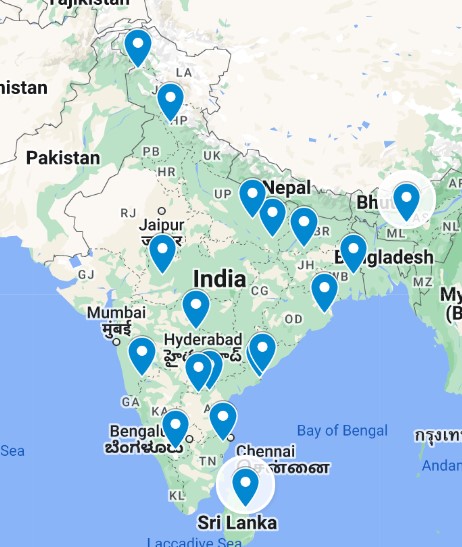
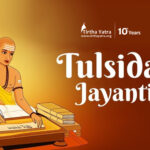
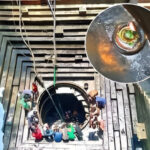
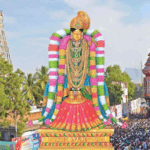


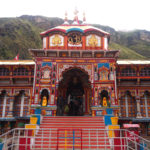
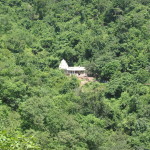
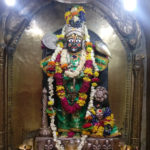
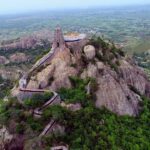
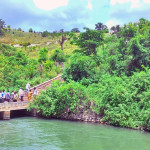
Leave a Reply